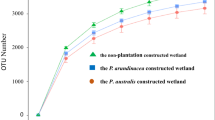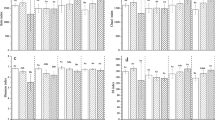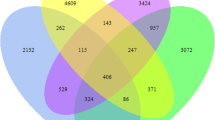Abstract
The Sanjiang Plain is the largest freshwater wetlands in Northeast China. In order to feed the growing population, about 84 % of the wetlands in this area have been converted to farmland, especially to paddy fields, since the 1950s. However, little is known about the influence of this conversion on soil microbial community composition. In this study, soil samples were collected from two natural wetlands dominated by plant species Carex lasiocarpa and Deyeuxia angustifolia and from a neighboring paddy field that was changed from wetland more than 10 years ago. The composition and diversity of bacterial communities in the soils were estimated by clone library analysis of nearly full length of 16S rDNA sequences. The results revealed that bacterial diversity was higher in paddy fields, and that the composition of bacterial communities differed among the three samples; the difference was more notable between the paddy field and two natural wetlands than between two natural wetlands. The distribution of clones into different bacterial phyla differed among soil samples, and the conversion from natural wetlands to paddy field increased the abundance of Proteobacteria and Firmicutes but decreased the abundance of Chloroflexi. About 63 % and 71 % of clones from two natural wetlands and 49 % of clones from the paddy field had <93 % similarity with known bacteria, suggesting that the majority of bacteria in natural wetland soils in the Sanjiang Plain are phylogenetically novel. In general, this study demonstrated that long-term conversion from natural wetlands to paddy field changes soil bacterial communities in the Sanjiang Plain.



Similar content being viewed by others
References
Asakawa S, Kimura M (2008) Comparison of bacterial community structures at main habitats in paddy field ecosystem based on DGGE analysis. Soil Biol Biochem 40:1322–1329
Ausec L, Kraigher B, Mandic-Mulec I (2009) Differences in the activity and bacterial community structure of drained grassland and forest peat soils. Soil Biol Biochem 41:1874–1881
Balasooriya WK, Denef K, Peters J, Verhoest NEC, Boeckx P (2008) Vegetation composition and soil microbial community structural changes along a wetland hydrological gradient. Hydrol Earth Syst Sci 12:277–291
Bossio DA, Scow KM (1998) Impacts of carbon and flooding on soil microbial communities: phospholipid fatty acid profiles and substrate utilization patterns. Microb Ecol 35:265–278
Bossio DA, Girvan MS, Verchot L, Bullimore J, Borelli T, Albrecht A, Scow KM, Ball AS, Pretty JN, Osborn AM (2005) Soil microbial community response to land use change in an agricultural landscape of western Kenya. Microb Ecol 49:50–62
Burton TM, Uzarski DG (2009) Biodiversity in protected coastal wetlands along the west coast of Lake Huron. Aquat Ecosyst Health 12:63–76
Carney KM, Matson PA (2006) The influence of tropical plant diversity and composition on soil microbial communities. Microb Ecol 52:226–238
Chao A (1984) Non-parametric estimation of the number of classes in a population. Scand J Stat 11:265–270
Chelius MK, Triplett EW (2001) The diversity of archaea and bacteria in association with roots of Zea may L. Microb Ecol 41:252–263
Chu HY, Fierer N, Lauber CL, Caporaso JG, Knight R, Grogan P (2010) Soil bacterial diversity in the Arctic is not fundamentally different from that found in other biomes. Environ Microbiol 12:2998–3006
Davidsson TE, Stepanauskas R, Leonardson L (1997) Vertical patterns in nitrogen transformations during infiltration in two wetland soils. Appl Environ Microbiol 63:3648–3656
Dedysh AN (2011) Cultivating uncultured bacteria from northern wetlands: knowledge gained and remaining gaps. Front Microbiol 2:1–15
Fierer N, Jackson RB (2006) The diversity and biogeography of soil bacterial communities. Proc Natl Acad Sci USA 103:626–631
Fierer N, Bradford M, Jackson R (2007) Toward an ecological classification of soil bacteria. Ecology 88:1354–1364
Garbeva P, Veen JAV, Elsas JDV (2004) Microbial diversity in soil: selection of microbial populations by plant and soil type and implications for disease suppressiveness. Annu Rev Phytopathol 42:243–270
Ge Y, He JZ, Zhu YG, Zhang JB, Xu Z, Zhang LM, Zheng YM (2008) Differences in soil bacterial diversity: driven by contemporary disturbances or historical contingencies? ISME J 2:254–264
Gutknecht JLM, Goodman RM, Balser TC (2006) Linking soil process and microbial ecology in freshwater wetland ecosystems. Plant Soil 289:17–34
Hammer Ø, Harper DAT, Ryan PD (2001) PAST: Paleontological statistics software package for education and data analysis. Palaeontol Electron 4:9pp
Han XY (2006) Bacterial identification based on 16S ribosomal RNA gene sequence analysis. In: Tang YW, Stratton SW (eds) Advanced techniques in diagnostic microbiology. Springer, New York, pp 323–332
Hartman WH, Richardson CJ, Vilgalys R, Bruland GL (2008) Environmental and anthropogenic controls over bacterial communities in wetland soils. Proc Natl Acad Sci USA 105:17842–17847
Huang Y, Sun WJ, Zhang W, Yu YQ, Su YH, Song CC (2010) Marshland conversion to cropland in northeast China from 1950 to 2000 reduced the greenhouse effect. Global Change Biol 16:680–695
Jangid K, Williams MA, Franzluebbers AJ, Sanderlin JS, Reeves JH, Jenkins MB, Endale DM, Coleman DC, Whitman WB (2008) Relative impacts of land-use, management intensity and fertilization upon soil microbial community structure in agricultural systems. Soil Biol Biochem 40:2843–2853
Jones RT, Robeson MS, Lauber CL, Hamady M, Knight R, Fierer N (2009) A comprehensive survey of soil acidobacterial diversity using pyrosequencing and clone library analyses. ISME J 3:442–453
Kanokratana P, Uengwetwanit T, Rattanachomsri U, Bunterngsook B, Nimchua T, Tangphatsornruang S, Plengvidhya V, Champreda V, Eurwilaichitr L (2011) Insights into the phylogeny and metabolic potential of a primary tropical peat swamp forest microbial community by metagenomic analysis. Microb Ecol 61:518–528
Keller JK (2011) Wetlands and the global carbon cycle: what might the simulated past tell us about the future? New Phytol 192:789–792
Lane DJ (1991) 16S/23S rRNA sequencing. In: Stackebrandt E, Goodfellow M (eds) Nucleic acid techniques in bacteria systematics. Wiley, Chichester, pp 115–175
Liu XT, Ma XH (2000) Influence of large scale reclamation on natural environment and regional environmental protection in the Sanjiang Plain (in Chinese with English abstract). Sci Geogr Sin 20:14–19
Lozupone C, Knight R (2005) UniFrac: a new phylogenetic method for comparing microbial communities. Appl Environ Microbiol 71:8228–8235
Magurran AE (1996) Ecological diversity and its measurement. Chapman Hall, London
Mausbach MJ, Parker WB (2001) Background and history of the concept of hydric soils. In: Richardson JL, Vepraskas MJ (eds) Wetland soils. Lewis, New York, pp 19–34
McJannet D, Wallace J, Keen R, Hawdon A, Kemei J (2012) The filtering capacity of a tropical riverine wetland: I. Water balance. Hydrol Process 26:40–52
Mitsch WJ, Gosselink JG (2007) Wetlands. Hoboken, New Jersey
Pankratov TA, Ivanova AO, Dedysh SN, Liesack W (2011) Bacterial populations and environmental factors controlling cellulose degradation in an acidic Sphagnum peat. Environ Microbiol 13:1800–1814
Rousk J, Bååth E, Brookes PC, Lauber CL, Lozupone C, Caporaso JG, Knight R, Fierer N (2010) Soil bacterial and fungal communities across a pH gradient in an arable soil. ISME J 4:1340–1351
Schloss PD, Westcott SL, Ryabin T, Hall JR, Hartmann M, Hollister EB, Lesniewski RA, Oakley BB, Parks DH, Robinson CJ, Sahl JW, Stres B, Thallinger GG, Van Hom DJ, Weber CF (2009) Introducing mothur: open source, platform-independent, community-supported software for describing and comparing microbial communities. Appl Environ Microbiol 75:7537–7541
Smit E, Leeflang P, Gommans S, van den Broek J, van Mil S, Wernars K (2001) Diversity and seasonal fluctuations of the dominant members of the bacterial soil community in a wheat field as determined by cultivation and molecular methods. Appl Environ Microbiol 67:2284–2291
Song C, Yan B, Wang Y, Wang Y, Lou Y, Zhao Z (2003) Fluxes of carbon dioxide and methane from swamp and impact factors in Sanjiang Plain, China. Chin Sci Bull 48:2749–2753
Tamura K, Dudley J, Nei M, Kumar S (2007) MEGA4: Molecular Evolutionary Genetics Analysis (MEGA) software version 4.0. Mol Biol Evol 24:1596–1599
Thompson JD, Gibson TJ, Plewniak F, Jeanmougin F, Higgins DG (1997) The Clustal X windows interface: flexible strategies for multiple sequence alignment aided by quality analysis tools. Nucleic Acids Res 24:4876–4882
Wang DX, Liu XG, Ding WX, Cai ZC, Wang YY (2002) Comparison of methane emission from marsh and paddy field in Sanjiang Plain (in Chinese with English abstract). Sci Geogr Sin 22:500–503
Wang Q, Garrity GM, Tiedje JM, Cole JR (2007) Naïve bayesian classifier for rapid assignment of rRNA sequences into the new bacterial taxonomy. Appl Environ Microbiol 73:5261–5267
Wang GH, Xu YX, Jin J, Liu JJ, Zhang QY, Liu XB (2009) Effect of soil type and soybean genotype on fungal community in soybean rhizosphere during reproductive growth stages. Plant Soil 317:135–144
Wang WW, Niu J, Zhou XQ, Wang YF (2011) Long-term change in land management from subtropical wetland to paddy field shifts soil microbial community structure as determined by PLFA and T-RFLP. Pol J Ecol 59:37–44
Yu ZH, Wang GH, Jin J, Liu JD, Liu XB (2011) Soil microbial communities are more affected by land use than seasonal variation in restored grassland and cultivated Mollisols in Northeast China. Eur J Soil Biol 47:357–363
Zak DR, Holmes WE, White DC, Peacock AD, Tilman D (2003) Plant diversity, soil microbial communities, and ecosystem function: are there any links? Ecology 84:2042–2050
Zhang JB, Song CC, Yang WY (2007a) Tillage effects on soil carbon fractions in the Sanjiang Plain, Northeast China. Soil Till Res 93:102–108
Zhang JB, Song CC, Yang WY (2007b) Effects of cultivation on soil microbiological properties in a freshwater marsh soil in Northeast China. Soil Till Res 93:231–235
Zhao KY (1999) Mires in China. Science Press, Beijing
Zheng CY, Wang GH, Liu JJ, Song CC, Gao HX, Liu XB (2013) Characterization of the major capsid gene (g23) of T4-type bacteriophages in the wetlands of Northeast China. Microb Ecol 65:616–625
Acknowledgments
We thank Professor Makoto Kimura of Nagoya University, Japan for his valuable comments and critical review of this manuscript. This work was supported by grants from Chinese Academy of Sciences for the Hundred Talents Program and Heilongjiang Province Natural Science Funds for outstanding youth (JC201116), as well as Chinese Academy of Sciences visiting professorship for senior international scientists (2011T2Z14).
Author information
Authors and Affiliations
Corresponding author
Additional information
Junjie Liu and Chunyu Zheng contributed equally to this work
Rights and permissions
About this article
Cite this article
Liu, J., Zheng, C., Song, C. et al. Conversion from natural wetlands to paddy field alters the composition of soil bacterial communities in Sanjiang Plain, Northeast China. Ann Microbiol 64, 1395–1403 (2014). https://doi.org/10.1007/s13213-013-0784-9
Received:
Accepted:
Published:
Issue Date:
DOI: https://doi.org/10.1007/s13213-013-0784-9




